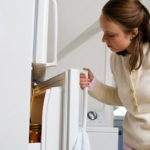“Humid weather” is a familiar phenomenon for people in the North. Walls, floors, and objects with hard surfaces such as wood, stone, and glass often condensate or “sweat,” causing inconvenience in daily life and significantly affecting people’s health.

In addition, prolonged exposure to humid air can cause furniture to deteriorate, malfunction, and develop mold and bacteria, harmful to users. Therefore, knowing how to best protect belongings during this period is a concern for many.
A universal method to preserve furniture during humid weather
1. Use a dehumidifier
Using a dehumidifier is an effective solution to tackle humidity issues indoors. Place the machine in hidden corners, behind furniture, and other damp areas in your home. This approach will help keep your furniture dry and provide excellent protection.

2. Turn on the air conditioner in dry mode
With high humidity, if you have a two-way air conditioner, turn it on in dry mode. This is a great way to dehumidify and improve air circulation, protecting the health of your family members, especially those with young children. Remember to close all doors to ensure the air conditioner works efficiently and saves energy. A dry indoor space will prevent furniture from getting damp and moldy.
3. Keep doors closed
We often mistakenly believe that during humid weather, we should open doors to speed up drying. However, when it’s humid, the moisture in the air and wind will make the floor wet. Opening doors does not help the floor dry faster but instead worsens the situation, as the moist air can rise and cling to objects placed on the floor. So, keep doors closed unless necessary.

4. Don’t turn on the fan
Many people turn on the fan when their house is damp, thinking it will dry faster. However, this has the opposite effect. The fan creates wind, which draws in moist air, making your home even damper. Therefore, refrain from using the fan during humid weather.
Tips for preserving furniture during humid weather, categorized by material
1. How to protect wooden furniture
Wood is the most commonly used material for furniture and is also the most susceptible to mold and mildew during prolonged humid weather. To protect your wooden furniture, consider the following tips:

– Preserve wooden furniture with desiccant bags:
Desiccant bags, though small, are incredibly useful in combating moisture in wooden furniture, especially during humid periods. These bags are readily available in packaged foods and personal care products. Collect them and place them inside wooden items. Desiccant bags will effectively prevent condensation and mold on wood surfaces.
– Use dry cloths to wipe down wooden furniture:
Whether natural or engineered, wood can be damaged by excessive moisture. Your wooden tables and chairs can easily swell, deform, and crack. Moreover, damp wood creates an ideal environment for mold growth, leading to wood rot. Therefore, during humid periods, have dry cloths ready to wipe down wooden surfaces regularly to keep them dry.

– Remove mold with sandpaper and apply a glossy finish:
If your wooden furniture has developed a layer of white mold and emits an unpleasant odor, address it immediately. Use sandpaper to gently rub off the outer layer of mold, then apply a coat of glossy paint with anti-moisture properties. This method will not only eliminate mold but also enhance the shine and beauty of your wooden furniture.
2. How to preserve fabric furniture
Fabric and velvet are prone to dirt, sweat, and moisture, especially in rainy weather. Over time, these materials will discolor, lose their original color, and develop white or yellow mold spots. Prolonged exposure to humidity will cause them to lose elasticity, reducing their ability to stretch while increasing their volume. Once the humid period passes, fabric furniture will become fragile and prone to damage.

Preservation methods:
– If your fabric sofa gets damp, use a hairdryer to dry it. For more intricate sofa designs, use a vacuum cleaner to remove dust and dry it.
– Avoid placing the sofa against the wall, as it hinders air circulation, making it more susceptible to moisture from the wall. This increases the risk of mold and mildew during high-humidity periods.
– For bedding, wash frequently and use a clothes dryer to ensure thorough drying to prevent mold.
3. How to preserve leather furniture
Whether genuine or synthetic, leather furniture that remains in a humid environment for an extended period will discolor, and the leather will become stiff. In environments with humidity above 90%, leather is prone to mold.

Treatment and preservation methods:
If your leather furniture develops mold, use a soft damp cloth to wipe it clean. For leather furniture without mold, dust it with a soft cloth, then apply a layer of mink or lanolin oil to its surface. This method not only helps repel moisture but also preserves the color of your leather furniture.
4. How to preserve rattan furniture
If rattan furniture remains damp for a long time, it will turn black and eventually rot, significantly reducing its durability and flexibility.
Preservation method:
Use saltwater to clean and remove dirt, making the rattan softer, more elastic, and durable.

5. How to preserve metal furniture
Metal furniture, such as table and chair legs, cabinets, and doors, is less susceptible to mold and mildew than other materials, especially with the widespread use of electrostatic paint for water and corrosion resistance. However, in some cases, metal objects can still rust and eventually rot due to prolonged exposure to high moisture levels in the air.
Preservation method:
During rainy and humid days, it is best to use a dry cloth to wipe down metal surfaces and absorb moisture. Avoid prolonged contact between metal objects and water.
By V.K – Vietnamnet



































